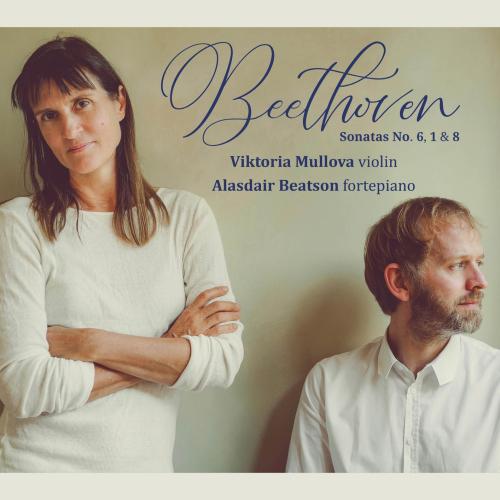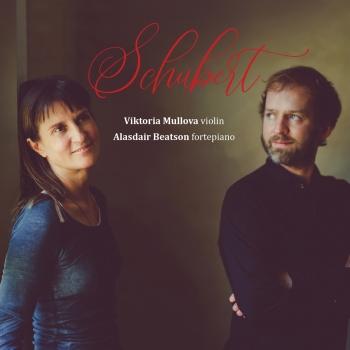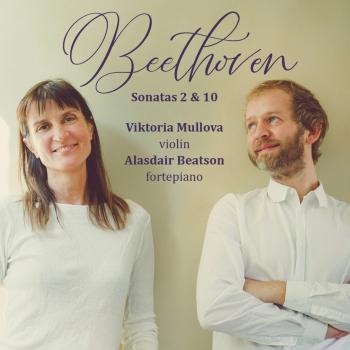
Beethoven Violin Sonatas Nos. 6, 1 and 8 Viktoria Mullova & Alasdair Beatson
Album Info
Album Veröffentlichung:
2024
HRA-Veröffentlichung:
03.05.2024
Label: Signum Records
Genre: Classical
Subgenre: Instrumental
Interpret: Viktoria Mullova & Alasdair Beatson
Komponist: Ludwig van Beethoven (1770-1827)
Das Album enthält Albumcover Booklet (PDF)
- Ludwig van Beethoven (1770 - 1827): Violin Sonata No. 6 in A Major, Op. 30 No. 1:
- 1 Beethoven: Violin Sonata No. 6 in A Major, Op. 30 No. 1: I. Allegro 07:23
- 2 Beethoven: Violin Sonata No. 6 in A Major, Op. 30 No. 1: II. Adagio molto espressivo 06:09
- 3 Beethoven: Violin Sonata No. 6 in A Major, Op. 30 No. 1: III. Allegretto con variazioni 07:53
- Violin Sonata No. 1 in D Major, Op. 12 No. 1:
- 4 Beethoven: Violin Sonata No. 1 in D Major, Op. 12 No. 1: I. Allegro con brio 08:19
- 5 Beethoven: Violin Sonata No. 1 in D Major, Op. 12 No. 1: II. Andante con moto. Tema con variazioni 06:41
- 6 Beethoven: Violin Sonata No. 1 in D Major, Op. 12 No. 1: III. Rondo. Allegro 04:28
- Violin Sonata No. 8 in G Major, Op. 30 No. 3:
- 7 Beethoven: Violin Sonata No. 8 in G Major, Op. 30 No. 3: I. Allegro assai 06:07
- 8 Beethoven: Violin Sonata No. 8 in G Major, Op. 30 No. 3: II. Tempo di Minuetto, ma molto moderato e grazioso 06:51
- 9 Beethoven: Violin Sonata No. 8 in G Major, Op. 30 No. 3: III. Allegro vivace 03:26
Info zu Beethoven Violin Sonatas Nos. 6, 1 and 8
Drei von Beethovens hochoriginellen Violinsonaten—die Salieri zugeeignete Nr. 1, und Nr. 6 und 8 aus Opus 30, das Zar Alexander I. gewidmet ist—in Aufführungen, die jede Nuance voll zur Geltung bringen.
Auf ihrem zweiten Duo-Album bei Signum Classics spielen Viktoria Mullova und Alasdair Beatson die Sonaten 6, 1 und 8 von Beethoven. Wie bei früheren Aufnahmen verwenden sie eine Kopie eines Walter von 1805 (ein Wiener Hammerflügel) von Paul McNulty; zusammen mit einer mit Darm bespannten Violine sind diese Instrumente genau das, wonach sich Beethovens Musik sehnt, da sie eine reiche Textur und deutliche Farben zwischen den Registern bieten.
Bei der Vorbereitung dieser Einspielung haben sich diese drei Sonaten als besonders gute Begleiter erwiesen - in ihrer Gesamtheit sind sie optimistisch, überschwänglich und unerschöpflich erfinderisch. Wie bei früheren Aufnahmen verwenden wir eine Kopie eines Walter von 1805 (ein Wiener Hammerflügel) von Paul McNulty; zusammen mit einer mit Darm bespannten Violine sind diese Instrumente echte Kollegen, die uns informieren und inspirieren und uns zu Beethovens Stimme und Ausdruck überreden. Für mich ist der texturale Reichtum des Hammerflügels in dieser Musik eine Offenbarung. Beethoven balanciert und belebt die unterschiedlichen Farben der verschiedenen Register des Instruments wie ein meisterhafter Mixologe! Violine und Hammerflügel artikulieren, unterhalten und singen mit natürlicher Leichtigkeit miteinander.
Beethoven hat für seine Violinsonaten keine Metronomangaben gemacht, und bei den Proben hat uns unser Instinkt zu vergleichsweise schnellen und beschwingten Tempi geführt. Unsere Vorlieben stimmen mit den Metronomempfehlungen von Beethovens Zeitgenossen (einschließlich Czerny und Moscheles) überein und wirken dem Trend der Aufführungstraditionen des späteren 19. und 20. Jahrhunderts entgegen, als wesentlich langsamere Tempi zur Norm wurden.
So we enjoy an abundance of vigour and elan in the outer movements of the D major sonata, Op 12 No 1, Beethoven embarking on his first sonata for the idiom with characteristic confidence and brilliance. Meanwhile, in its exquisite central movement Andante con moto, a set of variations provides repose, intimacy and increasing fantasy. ...
Viktoria Mullova, violin
Alasdair Beatson, fortepiano
Viktoria Mullova
studied at the Central Music School of Moscow and the Moscow Conservatoire. Her extraordinary talent captured international attention when she won first prize at the 1980 Sibelius Competition in Helsinki and the Gold Medal at the Tchaikovsky Competition in 1982 which was followed, in 1983, by her dramatic and much publicized defection to the West. She has since appeared with most of the world’s greatest orchestras and conductors and at the major international festivals. She is now known the world over as a violinist of exceptional versatility and musical integrity. Her curiosity spans the breadth of musical development from baroque and classical right up to the most contemporary influences from the world of fusion and experimental music.
Her interest in the authentic approach has led to collaborations with period instrument bands such as the Orchestra of the Age of Enlightenment, Il Giardino Armonico, Venice Baroque and Orchestre Révolutionnaire et Romantique. She has a close association with harpsichordist Ottavio Dantone with whom she tours and which led Tim Ashley to write, “To hear Mullova play Bach is, simply, one of the greatest things you can experience…” in the Guardian. Her recording of Bach’s solo sonatas and partitas represents a significant milestone in Viktoria’s personal journey into this music. The recording received 5-star reviews from all over the world and she is embarking on an international several season-long, series of solo Bach recitals.
Her ventures into creative contemporary music started in 2000 with her album ”Through the Looking Glass“ in which she played world, jazz and pop music arranged for her by Matthew Barley. Her exploration continues, commissioning works from young composers such as Fraser Trainer and Thomas Larcher and she has recently released a new CD ”The Peasant Girl“, a project with the Matthew Barley Ensemble in which they perform music from a diverse musical canvas with roots in classical, gypsy and jazz. There will be a much-anticipated performance of this project at the BBC Late Night Proms in August 2011 with future concerts in Russia, Paris, Germany, Italy and the UK.
Her rich musical diversity has been celebrated in several high-profile residencies, including London’s Southbank, Vienna’s Konzerthaus and in 10/11 she was the London Symphony Orchestra’s ”Artist in Focus“. In 2011/12 she is Artist in Residence at the Auditorium du Louvre in Paris and Musikfest Bremen.
As a recitalist, she regularly performs with Katia Labèque and she has recently formed a duo with the fortepianist Kristian Bezuidenhout, with whom she has recorded Beethoven sonatas. A familiar face on the international concert scene, she appears regularly with the world’s major orchestras and conductors. In the 11/12 season she appears with, among others, The Philharmonia and Esa-Pekka Salonen, Scottish Chamber Orchestra and Robin Ticciati, Swedish Radio Symphony, again with Esa-Pekka Salonen, Frankfurt Radio Symphony with Paavo Järvi and Russian National Orchestra with Mikhail Pletnev.
Mullova’s extensive discography for Philips Classics has attracted many prestigious awards. Her recording of the Vivaldi Concertos with Il Giardino Armonico and directed by Giovanni Antonini, won the Diapason D’Or of the Year award for 2005 and her most recent release, featuring Beethoven’s Op 12 No 3 and Kreutzer Sonatas with fortepianist, Kristian Bezuidenhout has won immense critical acclaim. Other discs have included the Schubert Octet with the Mullova Ensemble, ”Recital“ with Katia Labèque, Bach Sonatas with Ottavio Dantone and ”6 Solo Sonatas and Partitas“ by JS Bach.
Viktoria either plays on her ‘Jules Falk’ 1723 Stradivarius or a Guadagnini violin.
Booklet für Beethoven Violin Sonatas Nos. 6, 1 and 8












